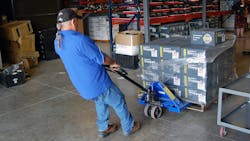The new tax law has good news and bad news for company drivers but mostly good news for owner-operators, lease operators and those who operate under their own authority. Carriers themselves will make out very well, too, according to Jim O'Donnell, CEO and Founder of Trucker Tax Service.
Nothing changes for the tax year 2017, notes O'Donnell who specializes in tax filings for Over-the-Road drivers receiving a W-2 from their employer. Starting in 2018, "W-2 drivers will no longer be able to itemize their expenses; nobody is going to be able to itemize come next year… the average aggressive driver who's out there 300 nights a year has about $15,000 in per diem deductions that he's entitled to. Then he takes the rest of his expenses that he has throughout the year starting with, say, a cell phone and anything else that he may have purchased, work boots, gloves, bed linens for the sleeper, anything, all the way down to the three-dollar air freshener. You add all of that up and our average company driver has about another $3,000 worth of expenses. All totaled, the average company driver was entitled to about $18,000 in deductions." This disappears under the new tax law. Under the new law, however, the standard deduction that everyone gets has almost doubled to $12,000 which should help the disappearance of itemization, but it doesn't go far enough.
But there is a workaround, and it has to do with per diem payments of which there are two kinds. "Up until now drivers were allowed to take per diem as a deduction, reducing their taxable income which would put more refund money in their pocket. Then there's the per diem that a company can pay drivers as part of their wage. Up until this year, and as we complete 2017 taxes, it will still be the case. If a driver is paid per diem, and let's says he makes 40 cents a mile, and 10 cents of that could be per diem wage which is not taxed. If the average drivers out there are driving 450 miles a day, so 10 cents of that or $45 per day is per diem. The company just pays it to him almost like a 1099 worker, like an owner-operator. If he's out there 300 days that is about $13,500 of his total wage that is not taxed."
Under the old tax law, we would add that per diem back in because if he itemizes he has to show that as income. But the $18,000 in deductions that we had easily offset the $13,500 so it made sense to itemize."
O'Donnell continues: "I have already heard from one client that his company is going to bump the per diem pay to 16 cents a mile which is just enormous. It becomes forty percent of their gross pay per diem and they don't have to claim that on their taxes. Again, that same driver who's at 40 cents a mile and drives, say, 450 miles a day and 300 days a year is going to make about $54,000. From that $54,000, about 40 percent or $21,600 he doesn't have to claim. Now, he's only claiming $32,400 as his income, and the rest of that, $21,600, stays in his pocket. It's literally reimbursement pay. Then the company writes that reimbursement payoff as part of their expense. Everybody wins in that respect if the company chooses to do that."
He adds: "I can't imagine that every company out there won't fall in line with that eventually because it's a benefit to everybody."
As for owner-operators, the new tax law should put more money in their pockets. Assuming an O-O is grossing $150,000 and nets about $50,000 on his schedule C - the profit and loss statement – he will get a 20 percent break and only $40,000 of it will get taxed. He's going to save about $10,000. "That will be a big savings for the owner-operator or lease operator, the guy who has his own authority or a small trucking company. All of those guys will benefit from this new tax law. It's only the company driver that's going to take the hit unless his company raises his per diem."
About the Author

Larry Kahaner
Larry Kahaner is an author, journalist, and former FleetOwner contributor.
